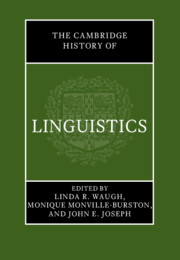Book contents
- The Cambridge History of Linguistics
- The Cambridge History of Linguistics
- Copyright page
- Dedication
- Contents
- Figures
- Tables
- Contributors
- Preface
- Acknowledgments
- Abbreviations, Acronyms, Special Symbols, and Other Conventions
- Introduction
- Part I Ancient, Classical, and Medieval Periods
- Part II Renaissance to Late Nineteenth Century
- Part III Late Nineteenth-through Twentieth-Century Linguistics
- Part IIIA Late Nineteenth Century through the 1950s: Synchrony, Autonomy, and Structuralism
- Part IIIB 1960–2000: Formalism, Cognitivism, Language Use and Function, Interdisciplinarity
- 17 Chomsky and the Turn to Syntax, Including Alternative Approaches to Syntax
- 18 Functionalist Dimensions of Grammatical and Discourse Analysis
- 19 Semantics and Pragmatics
- 20 Language and Philosophy, from Frege to the Present
- 21 Lexicology and Lexicography
- 22 Generative Phonology: its Origins, its Principles, and its Successors
- 23 Phonetics and Experimental Phonology, c. 1950–2000
- 24 Historical and Universal-Typological Linguistics
- 25 Language and Society
- 26 Language and Anthropology
- 27 Language and Psychology, 1950–Present: A Brief Overview
- 28 Semiotics
- 29 Applied Linguistics
- References
- Index
27 - Language and Psychology, 1950–Present: A Brief Overview
from Part IIIB - 1960–2000: Formalism, Cognitivism, Language Use and Function, Interdisciplinarity
Published online by Cambridge University Press: 20 July 2023
- The Cambridge History of Linguistics
- The Cambridge History of Linguistics
- Copyright page
- Dedication
- Contents
- Figures
- Tables
- Contributors
- Preface
- Acknowledgments
- Abbreviations, Acronyms, Special Symbols, and Other Conventions
- Introduction
- Part I Ancient, Classical, and Medieval Periods
- Part II Renaissance to Late Nineteenth Century
- Part III Late Nineteenth-through Twentieth-Century Linguistics
- Part IIIA Late Nineteenth Century through the 1950s: Synchrony, Autonomy, and Structuralism
- Part IIIB 1960–2000: Formalism, Cognitivism, Language Use and Function, Interdisciplinarity
- 17 Chomsky and the Turn to Syntax, Including Alternative Approaches to Syntax
- 18 Functionalist Dimensions of Grammatical and Discourse Analysis
- 19 Semantics and Pragmatics
- 20 Language and Philosophy, from Frege to the Present
- 21 Lexicology and Lexicography
- 22 Generative Phonology: its Origins, its Principles, and its Successors
- 23 Phonetics and Experimental Phonology, c. 1950–2000
- 24 Historical and Universal-Typological Linguistics
- 25 Language and Society
- 26 Language and Anthropology
- 27 Language and Psychology, 1950–Present: A Brief Overview
- 28 Semiotics
- 29 Applied Linguistics
- References
- Index
Summary
The chapter provides an overview of work that crosses the linguistics-psychology boundaries.
It presents early influential contributions/developments: Piaget and Vygotsky, Skinner’s behaviorist treatment of language acquisition (and Chomsky’s criticism), computer programming formalism, and the Chomskyan and cognitive revolutions.
It then analyzes research developments from the 1950s, reviews the tenets of generative grammar (especially Universal Grammar) and their role in sentence processing theories (garden-path theory, connectionist models) and describes models of discourse processing, e.g., mental/situation models, Construction-Integration model.
Other topics discussed are:
- Child language acquisition: its empirical foundations and Chomskyan views about language learnability (poverty of stimulus, critical period of development).
- Formalization of language processing with computing tools: simulation of language processes, description of representations underlying language processing (e.g., semantic networks, scripts, ACT CCREADER); computational linguistics (e.g., speech recognition, automated translation); corpus linguistics.
- Social dimensions of language use: pragmatics (Grice’s conversational maxims, Relevance Theory); social psychology (Communication Accommodation Theory).
- Neurolinguistics: disorders resulting from brain damage; technical advances in brain imaging methods and new insights about language processing networks.
- Gesture and sign language: gesture-thought relationship; study of sign languages.
- Cognitive linguistics and the claim that cognitive structures and representational schemes contribute to shaping language structure (e.g., Cognitive Grammar).
Keywords
- Type
- Chapter
- Information
- The Cambridge History of Linguistics , pp. 833 - 858Publisher: Cambridge University PressPrint publication year: 2023

